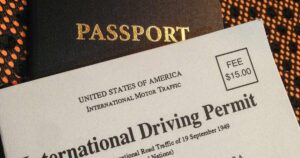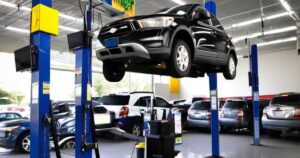Having an ignition switch go bad can leave you stranded and unable to start your car. But there are some steps you can try to get your engine turned over, even with a faulty ignition.
This involves bypassing certain security features and manually triggering starter operation. With some basic mechanical skills and simple tools like a screwdriver, many drivers can temporarily overcome ignition issues.
Understanding the right techniques to activate starter motor function without a working ignition can get your car mobile again. This allows you to drive to a repair shop for a more permanent fix.
How does the ignition switch work?
The ignition switch is the key mechanism that gets your engine started. When you insert the key and turn it to the On and Start positions, it activates different electrical circuits. These circuits provide power to the starter motor which cranks the engine, as well as other essential components like the fuel pump, ignition system, and dashboard gauges.
The ignition switch is also tied to the steering wheel lock, so the wheel is freed when you insert the key. If this ignition switch assembly fails, the engine will not start and the car cannot be steered.
USE JUMPER CABLES
Here’s a basic guide on how to jump-start a car using jumper cables:
Materials Needed:
- Jumper cables
- A functioning vehicle with a charged battery
- A vehicle with a dead battery
Position the Vehicles:
- Park the functioning vehicle close to the one with the dead battery, ensuring that the two vehicles are not touching.
- Make sure both cars are in park (for automatic transmissions) or neutral (for manual transmissions) and turn off the ignition in both cars.
Identify the Positive and Negative Terminals:
- Open the hoods of both vehicles.
- Identify the positive (+) and negative (-) terminals on each battery. They are usually marked with red and black colors, respectively.
Attach the Jumper Cables:
- Take one end of the red jumper cable and attach it to the positive terminal of the dead battery.
- Attach the other end of the red cable to the positive terminal of the functioning battery.
- Take one end of the black jumper cable and attach it to the negative terminal of the functioning battery.
IMPORTANT
Instead of attaching the other end of the black cable to the negative terminal of the dead battery, connect it to an unpainted metal surface of the car with the dead battery. This helps prevent sparks near the battery.
Start the Functioning Vehicle:
- Start the engine of the functioning vehicle and let it run for a few minutes. This will help charge the dead battery.
Start the Dead Vehicle:
- Attempt to start the car with the dead battery. If it doesn’t start, wait a few more minutes and try again.
Remove the Jumper Cables:
- Once the dead vehicle starts, carefully remove the jumper cables in the reverse order:
- Remove the black cable from the previously dead car’s metal surface.
- Remove the black cable from the functioning car’s negative terminal.
- Remove the red cable from the functioning car’s positive terminal.
- Finally, remove the red cable from the previously dead car’s positive terminal.
Let the Jumped Vehicle Run:
- Allow the car with the previously dead battery to run for at least 15 minutes to charge its battery.
Bad Ignition Switch Symptoms

There are a few common signs that indicate a failing or faulty ignition switch. The most obvious is turning the key and nothing happens – the engine won’t crank over or start.
You may be able to wiggle the key in the ignition and temporarily get it to start. Or the engine may die while driving due to switch failure.
Other symptoms include dashboard lights and electronics cutting in and out, the key sticking in the ignition, and problems removing the key. If you experience consistent issues turning the key, starting the engine, or electrical malfunctions, the cause is likely a bad ignition switch needing repair.
Difficulty Starting the Engine
The most common symptom of a bad ignition switch is trouble getting the engine to start. Despite turning the key, the starter won’t engage to crank the engine.
This happens because the switch fails to send the electrical signal to activate the starter. The engine may crank slowly or not at all when trying to start. Persistent issues with the engine failing to turn over likely point to ignition switch problems.
Stalling or Shutting Off While Driving
A faulty ignition switch can cause the engine to suddenly stall or shut off while driving. This dangerous symptom happens because the switch fails to maintain consistent electrical connections as vibrations occur. Loss of power while driving could also indicate switch damage or wear. Any stalling or dying out should be inspected for ignition issues.
Electrical Issues
Since the ignition switch controls power to essential vehicle electronics, problems can manifest as electrical glitches. Warning lights may flicker or dashboard gauges may cut out intermittently. Lights, radio, or accessories may randomly fail to work. These are signs the switch is making faulty electrical connections, preventing proper power distribution.
Key Won’t Turn In Ignition
Excessive resistance or inability to turn the key indicates potential switch damage. If the key seems stuck and won’t move into the Start position, it could mean wear or debris inside the switch mechanism. Sticking keys point to issues with the switch components and connectivity.
Start car with bad ignition switch

With a faulty ignition switch, you can attempt to manually power the starter to get the engine cranked. Remove the key and open the hood. Locate the starter solenoid and use a screwdriver to connect the positive and negative terminals.
This should engage the starter so the engine cranks. The car can then be started with ignition in the On position. Use caution not to touch battery components to avoid shock. This is only a temporary fix to start the car, the ignition switch will still need replacement for a permanent repair.
Troubleshooting and Identifying the Problem
If your car won’t start, first diagnose and confirm it is a bad ignition switch at fault. Check for dash lights and accessory power with the key on. Try jiggling the key while turning to start.
If the switch seems loose or starting only works in certain key positions, it likely needs replacement. Testing relays, starters, and connections can help narrow down the issue.
Temporary Fixes and Workarounds for Starting Your Car
There are makeshift methods to get the car started temporarily with ignition problems. You can connect starter relay terminals with a screwdriver to manually engage the starter. Removing the switch to hotwire starter wires together can work too. These are just temporary fixes to start the vehicle so you can drive to a repair shop.
Tap the Ignition Switch Gently
Lightly tapping or striking the ignition switch assembly may temporarily jostle the contacts into reconnecting. The vibration can help if the issue is a loose component or dirty electrical connections. Just be careful not to damage plastic components.
Wiggle the Key
While trying to start the car, gently wiggle the key back and forth in the ignition cylinder. This twisting motion can scrape away debris or oxidation to regain conductivity. The key movement may line up open contacts just long enough to start the engine.
Lubricate the Key and Lock Cylinder
Using lubricant sprays like WD-40 can wash away contaminants inside the switch cylinder. Slowly work the lubricated key in and out while trying to start. This can reestablish connectivity until repairs are made. Just avoid over-saturating the ignition components.
Use an Electrical Cleaner on the Switch Contacts
Special electrical contact cleaners help remove oxidation and improve connectivity. Spraying down into the ignition cylinder and working the key can dissolve built-up deposits. Let components fully dry before trying to start the car after using electrical cleaning sprays.
Alternative Methods to Start Your Car With Bad Ignition Switch
In some cases, alternative tactics like push starting are an option for vehicles with manual transmissions. This involves pushing the car to higher speeds while in gear and releasing the clutch to crank the engine.
Bumping or repeatedly turning the key may get it to start temporarily. Using the remote start on newer key fob models can also work around a bad switch to start driving.
Bypass the Ignition Switch
Locate the ignition switch wiring harness and disconnect it. Then find the starter wire and connect it to a spare momentary button. Push the button to engage the starter and start the car without the switch. This bypasses the bad components.
Hotwiring Your Car
You can start the engine by directly connecting and touching starter wires together. This dangerous method engages the starter motor directly for ignition-free starting. It completely bypasses the switch by hotwiring like in movies.
Using Remote Starter Switch
If your car has an aftermarket remote starter installed, try using the remote fob button. This activates the starter motor separately from the ignition switch. Get inside immediately once the engine is running.
Using Jump-Starting Method
A dead battery can sometimes mimic ignition switch failure. Jump starting the car with cables and a good battery can provide enough power to engage the starter. This rules out battery issues versus ignition problems.
Frequently Asked Questions
Can you start a car without an ignition switch?
Yes, you can manually hotwire the starter motor to crank the engine without using the ignition switch.
How to start my car if the key in the ignition switch will not turn?
Try spraying lubricant into the cylinder and wiggling the key gently to get it to turn to the Start position.
How do you bypass a bad ignition switch?
Disconnect the switch wiring harness and connect a push button to engage the starter directly.
Can ignition interlock cause a car not to start?
Yes, faulty or improperly calibrated interlock devices can prevent the engine from starting.
Can you fix an ignition switch without replacing it?
You may be able to clean contacts and fix connectivity issues, but replacement is usually required for broken switches.
Final Thoughts
Trouble starting your car is often the first sign of ignition switch failure. But there are methods to bypass the switch and power the starter manually for temporary operation. Simple fixes like wiggling the key or tapping the switch can temporarily reconnect faulty contacts.
Spray lubricants and electrical cleaners can also clear debris and corrosion. In some cases, you may need to hotwire starter wires directly together, bypassing the switch completely. While these techniques can get your car started as a short-term fix, the ignition switch will still need professional replacement for a permanent solution.
But overcoming ignition issues with makeshift starting methods allows you to drive to a repair shop to have the switch properly fixed. With some basic tools and knowledge of ignition components, you can overcome a bad switch in a pinch. Just be cautious when attempting any hotwiring techniques.
How Much Time Can A Juvenile Get For Stealing A Car?

Hey there! I have 5 years of experienced repairing all makes and models. Specializes in engine diagnostics, brake repair, electrical systems, and teaching DIY maintenance tips. Passionate about keeping cars running safely.








